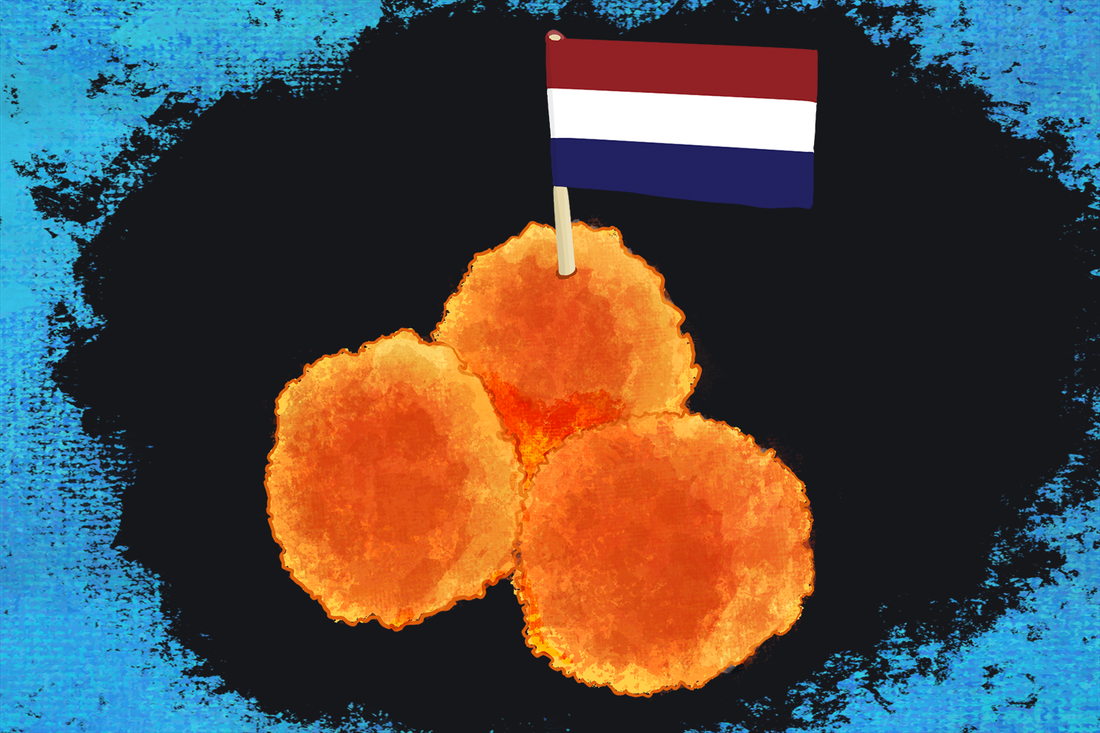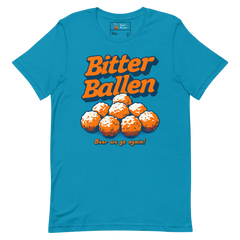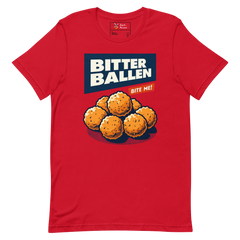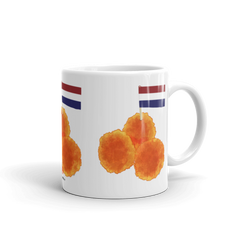Imagine strolling through the lively streets of Amsterdam or sitting in a cozy pub in Rotterdam, and you're likely to encounter a beloved Dutch snack that captivates both locals and tourists alike: Bitterballen. These scrumptious fried meatballs are a staple of traditional Dutch cuisine, renowned not only for their delicious taste but also for their role as a quintessential pub snack across the Netherlands.

Jump to a Section
- History of Bitterballen
- What Exactly are Bitterballen?
- Evolution of Bitterballen Over Time
- Cultural Significance and Variations
- The Art of Crafting Bitterballen<
- Serving and Enjoyment
- Best Places in Amsterdam to Try Bitterballen
History of Bitterballen
The origin of bitterballen can be traced back to the Batavi, an ancient Germanic tribe in the Netherlands. Their resourceful use of leftover ox meat, vegetables, and bread to feed hunters evolved through centuries. The turning point in bitterballen's culinary journey came with the Spanish occupation in the 16th century. The Spanish invaders introduced new cooking techniques, including the use of breadcrumbs and egg-wash which transformed the traditional stew into a fried delicacy. This innovation was embraced and further developed in Dutch kitchens, eventually making its way as a pub snack in the 18th century, popularized in part by the entrepreneurial spirit of tavern owners like Jan Barentz, whose wife served them to appease the appetites of their patrons.
Following its adoption into Dutch pub culture, bitterballen became a symbol of hospitality and warmth, often shared during times of celebration and social gathering. It’s this historical context that enriches each bite with a sense of tradition and community.
What Exactly are Bitterballen?
A quintessential Dutch treat, bitterballen are small, savory, and crunchy on the outside with a rich and molten interior. They are made from a thick meat ragout, commonly beef, that is bound with a buttery roux, flavored with nutmeg and parsley, and then chilled to firm up. This filling is then shaped into small balls, rolled in breadcrumbs, and deep-fried until golden. The texture contrast between the crispy exterior and the gooey center is a culinary delight. Bitterballen are often confused with kroketten, another Dutch favorite; while both are made from similar ingredients, kroketten are usually larger and log-shaped, and can be filled with a variety of ingredients including cheese or even seafood.
The preparation of bitterballen speaks to the Dutch penchant for using simple, hearty ingredients to create dishes that are both comforting and deeply satisfying. This process, emphasizing both technique and patience, is a testament to the culinary heritage that bitterballen have come from.
Help Support Our Site
Evolution of Bitterballen Over Time
While the essence of bitterballen as a savory, fried meatball has remained consistent through the centuries, its ingredients and preparation methods have seen various adaptations. Originally a simple dish made from leftover meats and bread, bitterballen have evolved into a gourmet snack that caters to a diverse array of tastes and dietary requirements.
In traditional recipes, beef was the primary ingredient, but modern variations include chicken, veal, and even fish or shrimp, reflecting broader changes in eating habits and ingredient availability. Vegetarian and vegan versions have also gained popularity, using mushrooms, lentils, or soy-based products as fillings, which mirror the rising trend in plant-based diets. Moreover, the advent of international spices and herbs has introduced new flavors to the traditional bitterballen palate, enhancing its appeal to modern taste preferences.
Additionally, cooking techniques have been refined to enhance the texture and flavor of bitterballen. Innovations in kitchen equipment allow for more consistent frying, resulting in a perfectly crispy exterior while retaining the gooey, rich interior. The adaptation of bitterballen recipes to suit modern cooking appliances like air fryers testifies to their enduring popularity while accommodating health-conscious lifestyles that prefer less oil in their diets.
These changes reflect not only the adaptability of bitterballen to the evolving culinary landscape but also the Dutch tradition of innovation and practicality in cuisine. Despite these changes, the core experience of enjoying a hot, crispy bitterbal dipped in mustard alongside a cold beer remains a quintessential Dutch culinary delight.
Cultural Significance and Variations
In Dutch society, bitterballen are more than mere fare; they represent a tradition of gathering, sharing, and celebrating. Found in nearly every pub and at family gatherings, these snacks are typically enjoyed with a dollop of mustard and a round of beers, facilitating social interaction and communal enjoyment. Over time, chefs and home cooks alike have experimented with the fillings, incorporating mushrooms, chicken, or even plant-based alternatives to appeal to a wider audience. Internationally, bitterballen have made their way into the menus of Dutch communities globally, including in Suriname and Indonesia, where they have been adapted to local tastes and ingredients.
This snack's adaptability has also led to its inclusion in various culinary events and competitions, where chefs aim to put their unique spin on the classic recipe. Such innovations include truffle-infused bitterballen, seafood varieties, and even dessert versions filled with sweet ingredients.
The Art of Crafting Bitterballen
Creating bitterballen at home is a rewarding endeavor that brings a piece of Dutch culinary heritage into your kitchen. Start by making a roux with butter and flour, to which you'll add beef broth, creating a thick base. Stir in finely chopped cooked beef and season with salt, pepper, nutmeg, and parsley. Once the mixture cools, form it into small balls. Each ball is then dipped in beaten egg, coated with breadcrumbs, and deep-fried until crispy. The key is to ensure the filling is creamy and flavorful, and the coating crispy. This process, while straightforward, requires attention to detail to achieve the perfect balance of textures and flavors.
For those looking to master the art of making bitterballen, it’s crucial to ensure the consistency of the roux is perfect—not too thin, nor too thick. Chilling the mixture adequately before forming it into balls is essential to maintain the shape during frying, and achieving that desired crispy exterior.
Serving and Enjoyment
Bitterballen are traditionally served hot with a side of sharp, tangy mustard that complements the rich, meaty flavor of the filling. The ideal beverage pairing is a cold Dutch beer (Heineken, Grolsch, Amstel, Brouwerij 't IJ, etc.), particularly those with a slight bitterness that enhances the savory snack. When serving, it's crucial to warn guests about the hot interior, which can surprise the uninitiated. The art of eating bitterballen involves biting through the crunchy exterior into the steamy, flavorful center—a ritual that is at the heart of the Dutch snacking experience.
The experience of enjoying bitterballen can be heightened by the setting—imagine sharing these with friends over laughter and good conversation, or as a comforting treat on a chilly evening. Each scenario underscores the versatility and universal appeal of this humble Dutch snack.
Whether you're exploring the city's bustling streets or relaxing by a tranquil canal, you'll find Bitterballen to be the perfect companion. To help you savor this Dutch delicacy, we’ve rounded up the best spots in Amsterdam where you can indulge in the most delicious and unique Bitterballen.
Best Places in Amsterdam to Try Bitterballen
-
De BallenBar (Website)
Located in the trendy Oud-West neighborhood within the Foodhallen, De BallenBar is the ultimate Bitterballen-tasting hotspot. The chefs have concocted several original flavors, including traditional Dutch beef, pulled pork, bouillabaisse, and Tom kha kai (Thai Coconut Soup). There are also vegetarian and vegan variants such as goat cheese, old Dutch cheese, home-grown parsnip, and soybean. -
Café de Tuin (Website)
This local cafe in Jordaan is a favorite among Amsterdammers for its affordable lunch options and excellent Bitterballen. The casual and relaxed vibe makes it an ideal place to unwind with friends over drinks and a plate of crispy, hot Bitterballen. -
Café Luxembourg (Website)
Located in the heart of Amsterdam's bustling city center, Café Luxembourg is known for its historic charm and delicious Bitterballen. This café has been serving tasty bites and cold drinks since 1921, making it a favorite among both locals and tourists. -
Café 't Smalle (Website)
Situated along the scenic Egelantiersgracht canal, Café ‘t Smalle is a charming brown cafe known for its authentic Dutch ambiance and excellent Bitterballen. Pair these savory treats with a local beer while soaking in the historic surroundings. -
Proeflokaal A. Van Wees (Website)
This traditional distillery and tasting room on the Herengracht serves classic Dutch flavors paired perfectly with their artisanal spirits. Proeflokaal A. Van Wees offers an atmospheric setting to enjoy Bitterballen along with local beers and jenevers. -
Café De Klos (Website)
Famous for its ribs, Café De Klos in the Jordaan neighborhood also serves some of the best Bitterballen in town. The rich and savory filling makes it a favorite among meat lovers and a perfect starter before diving into their main dishes. -
Eetsalon Van Dobben (Website)
Located in the Grachtengordel neighborhood, Eetsalon Van Dobben is a great place to sample a variety of traditional Dutch snacks, including delicious Bitterballen. This spot is perfect for those looking to enjoy authentic Dutch flavors at a reasonable price. -
Pllek (Website)
For a unique experience, hop on the ferry to NDSM-wharf and head to Pllek. This spot offers wild boar Bitterballen in a trendy setting made from disused shipping containers, complete with a beach and a wonderful view across the IJ. -
Gent aan de Schinkel (Website)
Just south of Vondelpark, Gent aan de Schinkel is known for its cozy vibe and tasty canalside snacking opportunities. The Bitterballen here come in classic meat or vegan varieties, with the option to supersize to an XL portion. -
Vegan Junk Food Bar (Website)
For those seeking a vegan option, Vegan Junk Food Bar offers plant-based Bitterballen in flavors like classic, mac & cheese, and peanut Thai. Enjoy these creative snacks in a funky atmosphere at one of their several locations in Amsterdam.
Conclusion
Bitterballen are more than just food; they are a cultural icon, embodying the spirit of Dutch culinary tradition. Whether you decide to make them at home or enjoy them in a bustling Dutch pub, these delightful snacks are sure to provide a taste of the Netherlands that is both comforting and exciting. So why not dive into the world of bitterballen and experience a piece of Dutch heritage firsthand?
References
Bitterballen. (n.d.). Wikipedia. Retrieved April 10, 2022, from https://en.wikipedia.org/wiki/Bitterballen
Cismaru, J. (2020, March 10). Dutch Meatballs (Bitterballen). Jo Cooks. Retrieved April 10, 2022, from https://www.jocooks.com/recipes/dutch-meatballs-bitterballen/
History of Dutch Snacks | Kickstart School. (2016, May 23). Kickstart School. Retrieved April 10, 2022, from https://kickstartschool.nl/en/posts/history-of-dutch-snacks
Longwell, L. (2021, December 21). Dutch Food: 18 Dishes to Try at Least Once. Travel Addicts. Retrieved April 10, 2022, from https://traveladdicts.net/dutch-food-and-drink-netherlands/







